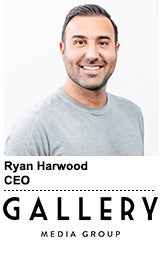Brands must be ubiquitous across platforms to remain relevant to their consumers. That requires producing content consistently and quickly – a trick publishers know well.
Gallery Media Group, the media umbrella within Gary Vaynerchuck’s holding company, VaynerX, aims to help brands solve their content needs by applying its distributed media playbook across Fortune 1000 clients.
“We’re trying to overdeliver on content creation but also give the distribution that a media company normally does,” said Ryan Harwood, CEO of Gallery Media Group.
Home to women’s lifestyle publisher PureWow and millennial men’s site ONE37PM, Gallery Media Group reaches 120 million people monthly across platforms. The group takes an unconventional approach to distribution; before creating a website, it launched ONE37PM, its newest property, first on Instagram, Twitter and YouTube, and then with a podcast and an Alexa skill.
“You can get a sense of how we’re thinking about the media landscape these days,” Harwood said. “We looked at areas where we felt like there was attention, but also where we felt it was going to continue to shift.”
AdExchanger: Why do brands work with Gallery Media Group?
RYAN HARWOOD: [Brands] come to us because of our ability to create high-quality content in a seamless, cost-efficient manner. That can manifest from branded content to storytelling. We use our media assets to distribute the content we create. We also have generous usage rights, so we allow [clients] to use content we create anywhere, including TV.
It’s really expensive to [work] with creative agencies as AORs, and it’s really expensive to build internal capabilities to publish the volume of content necessary to be relevant today.
Are you also a creative agency?
That heavy content creation arm could certainly be viewed as creative agency work. But I steer clear of the word agency, because it usually comes with a certain business model, which is not how we run our business.
We charge as a media company. You’re paying for distribution. The content is part of it, and if we have to break out production costs, we will. But you’re coming in through the lens of a media buy. We come up with a bespoke insertion order depending on the solution, which almost always includes content.
Why is Gallery leaning into experiential marketing for brands?
A big hack for creating a lot of content for a brand is growing an event. Experiential allows you to touch and feel the brand, but also come away with a thousand assets of consumers and influencers interacting with your brand in real time. If events allow us to produce an excessive amount of content brands can use on their O&O and we can distribute on ours, that’s a win.
[The Broadway play for Olay was] obviously very out there for a publisher. They came to us wanting to drive sales at certain retailers. We tested a few videos for them, [including] a longform video musical distributed through PureWow’s channels. It was a breakout hit, so we leaned into the musical genre with them. Why don’t we make this an Instagram-able, live experience?
How does influencer marketing fit into your strategy for brands?
We have two arms of our influencer business. One is the networks, like The Coterie and The Roster. Those are relationships we’re forming across likeminded creators that might be featured on our site or Instagram channels. We invite them to events. We look to them first when a brand comes to us. There’s speed because we already have the relationships, and there’s value because we can work with them more cost efficiently.
We also vet YouTube and Instagram influencers at scale. We’re doing deep analysis on the audience of the influencer and then picking one that looks and feels like the brand.
How does programmatic fit into your revenue strategy?
We do some PMPs, but I wouldn’t call it a major area of focus. We use our inventory for large content programs that we round out with display and video. We’ll create short-form assets out of long-form videos and retarget people to drive the conversion on other platforms.
Brand equity is the best direct response vehicle any publisher can offer. Nobody is going to be able to compete with the direct response capabilities of Facebook and Google. [But] PureWow is going to have more credibility with a 30-year-old woman.
How closely does Gallery Media Group work with VaynerMedia?
It’s complete church and state on the revenue and client side. They don’t work a ton with publishers. They don’t really do direct IO business. They do a ton of social and digital. They’re very scientific in the way they buy media.
One of the most beneficial things is there’s so much talent in the hallways. VaynerMedia might have someone who’s amazing at animation, and maybe we’ll freelance a project out to them. They helped us build a skill for PureWow. We’ve probably hired 10 people from VaynerMedia full time on our P&L because we felt they’d benefit Gallery Media Group more than any other part of the company.
This interview has been edited for clarity.














